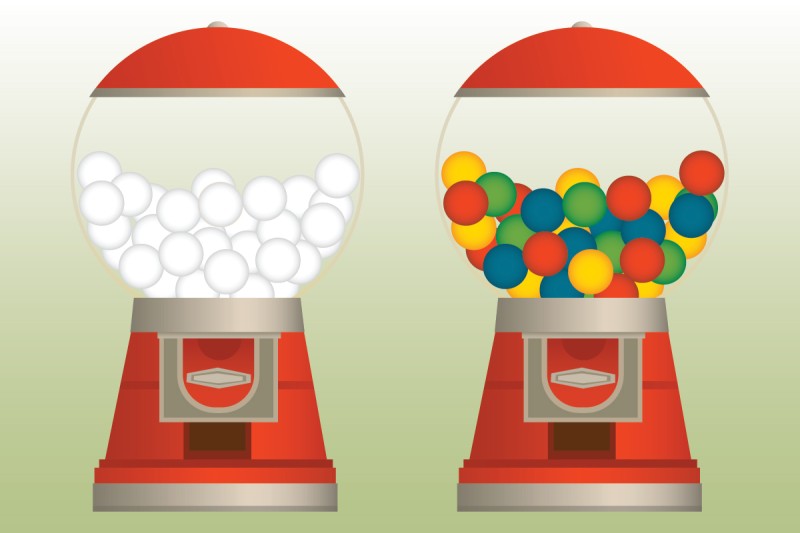
Until recently, the cells within a tumor were thought to be similar to one another at any given stage of the cancer, like the white gumballs in the machine on the left. But scientists are finding that a person's tumor cells can be highly diverse. This could mean that a biopsy may capture only a fraction of tumor cells that are not representative of the whole tumor, like a ball ejected at random from the machine on the right.
Every person’s cancer develops and grows in its own way and is unique in terms of what therapies it’s sensitive to. At Memorial Sloan Kettering and at other research centers around the world, the push is on to characterize the molecular variations between tumors — known as inter-tumor heterogeneity — and offer individualized treatments to more patients. That alone is a massive task.
And yet, according to some scientists, understanding how one person’s tumor differs from another’s may not be enough. Among those researchers is Memorial Sloan Kettering biologist Scott W. Lowe, who chairs the Cancer Biology and Genetics Program and the Geoffrey Beene Cancer Research Center. He thinks the next big quest in cancer science will be to peer ever more deeply into the genetics and biology of individual patients’ diseases and explore variations between subpopulations of tumor cells.
“We are increasingly becoming aware of the problem of intra-tumor heterogeneity, the fact that one person’s tumor cells can vary depending on where in the body they are located,” he says. “Even within the same tumor from the same patient, tumor cells might be subtly or even dramatically different. And there can be very important implications of this type of heterogeneity.”
Why It Matters
One implication is that more-sophisticated tools will be needed to characterize patients’ cancers and guide their treatment. Pathological examination of tumors often relies on needle biopsy, a procedure in which small samples of cells are extracted from a tumor for analysis. However, if doctors are dealing with a highly heterogeneous cancer, the tiny fraction of cells in the biopsy may not be representative of the entire tumor mass — which means important disease features might be missed.
“A potentially effective therapy could be overlooked because the indicator for that drug [such as a specific gene mutation] wasn’t found in the biopsy,” Dr. Lowe explains. “Or conversely, the wrong drug might be chosen if a biopsy reveals the presence of an indicator that isn’t actually that prevalent in the tumor.”
Intra-tumor heterogeneity may also explain, at least in part, why some patients who initially respond well to a cancer drug eventually relapse, often with new tumors that no longer respond to the therapy. The higher the diversity of cells within a tumor, the bigger the risk that an occasional cell might be able to adapt to the type of stress a drug imposes. If that cell then goes on to multiply and seed new cancer growth, it can potentially produce a drug-resistant tumor.
A Murky Field
Let’s pause for a bit and think about the staggering complexity of tumors. Given that every person’s cancer is different and that one person’s disease in itself can be a microcosm of cancer subtypes, it’s no wonder many tumors remain challenging to control even after decades of intensive research.
“What we’re learning is a bit daunting, in a sense,” Dr. Lowe says. “We’ve known for a long time that there are variances within tumors, but the depth of intra-tumor heterogeneity didn’t become apparent until recently when new technologies became available that allow us to really narrow in on single tumor cells and study their gene changes.”
Still, he remains optimistic. “Now that there is increasing awareness of the problem, and we are building the tools and resources to confront it, there will be enormous opportunity to finally get at some of the most pressing issues of cancer — like understanding why some drugs fail and what we can do to prevent it.”
New Ideas for Therapy
In fact, research in Dr. Lowe’s lab has already uncovered new aspects of intra-tumor heterogeneity that potentially could inform treatment. For example, many studies of the problem have focused on identifying genetic differences between a person’s tumor cells. But in a recent report in Nature, Dr. Lowe and his co-workers showed that the heterogeneity is not always genetic.
Working in mouse models of T cell acute lymphoblastic leukemia (ALL), an often aggressive type of blood cancer, the researchers found that tumor cells, even genetically identical ones, may behave differently depending on where in the body they are located. This is because the cells’ ability to grow and survive is influenced by the tissue microenvironment — the noncancerous tissues, cells, and molecules that exist close to the tumor.
The findings could have implications for how T cell ALL tumors in different body sites respond to PI3-kinase inhibitors, a new class of drugs entering clinical trials for the disease. “It’s conceivable that these drugs might be effective against tumors in some body sites but not others, depending on differences in the local environment,” Dr. Lowe notes.
The good news, he adds, is that a number of other drugs currently in development work by targeting cells or molecules in a tumor’s surroundings, preventing these factors from supporting tumor growth. Scientists hope it will be possible to eradicate some difficult-to-treat tumors in the future by combining drugs such as PI3-kinase inhibitors, which act on tumor cells, with drugs that work on the tumor microenvironment.
But Dr. Lowe emphasizes that a lot more research is needed. “There’s so much we still don’t know about the biology of tumors and their microenvironment,” he says, “and we are only beginning to understand the clinical implications of tumor heterogeneity and how to deal with them.”
